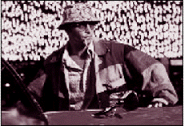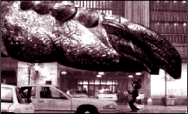
| In This Issue |
 |
 |
 |
![]()
[Editor's note: The following cinema review is written in the gonzo style of journalism. Reportage, after all, is a contact sport.]
The idea of filming Fear and Loathing in Las Vegas ought to set off a whole series of alarm bells in any sensible person's mind. Hunter S. Thompson's 1971 novel is practically a perfect example of the kind of thing that makes for great writing but that would inevitably fall flat on film. And I'm not even referring to the numerous scenes told from the perspective of someone under the influence of a shit-load of hallucinogenic drugs of various kinds, the type of experience that has translated universally into unintentionally laughable cinema.Having Terry Gilliam on board as director doesn't do much to alleviate the danger-it's not hard to imagine the Monty Python alum's hyper-caricatured visual style descending to the level of the ludicrous acid trips in the early Jack Nicholson bomb Psych Out. Moreover, The Fisher King demonstrated that Gilliam can be as turgidly pretentious as anyone working in Hollywood today, an approach that could also do its part to make a film version of Fear and Loathing pretty unpleasant.
Both these fears turn out to be completely justified. The hallucinations are rendered far too explicitly in both space and time, making them look like something out of a middle-of-the-road children's cartoon rather than the effects of an LSD trip. It's the ambiguity of such visions that makes them so difficult to describe, let alone render on film, and Gilliam's work here is simply another argument in favor of not attempting to do so. The scene in which the patrons of a hotel bar become vicious lizards is especially lame. The reptilian drunks look about as terrifying as the characters on that American talking-dinopuppet show they're showing on Russian TV now. Without this element of demented horror the scene's humor-such as when Duke tells his attorney they need to buy some golf shoes (the spikes of which will duplicate the reptiles' clawed feet) in order to be able to navigate the room's swamp-like floor to safety-loses all its bite. On the other hand, the shots of Duke's perplexed facial expressions as he voices over quotes from appropriate points in the novel do a reasonable job of approximating the mixture of paranoia and entertainment value of a serious hallucinogenic experience.
 |
Another problem is the celebrity cameos in the bit parts. It's hardly shocking that half the residents of the 90210 zip code wanted to take part of the project, but someone should have had the sense to draw a line in the sand at some point. Allowing a who's who of Hollywood to portray the anonymous denizens of 1971 Las Vegas turns this into a savage journey to the heart of an entirely different American dream.
Quite sensibly, the structure boils down to a series of lengthy voice-overs taken directly from the novel, punctuated by non-marijuana drug binges that make the closing scenes of Scarface or GoodFellas seem like The Big Chill by comparison. The closer the movie sticks to Thompson's prose, the more effective it is. In the character of Raoul Duke, Johnny Depp turns in another solid performance, confirming his claim to the title of hardest-working chameleon in show business. It's bewildering how much he looks like Hunter Thompson (and how little like Johnny Depp), even if the sculptured bald spot does strain the limits of believability.
But the truly frightening transformation is that of usual Hispanic criminal suspect Benicio Del Toro into the hefty Samoan attorney Dr. Gonzo. He might not be as massive as you'd expect from the book (or from the "mind-twirling" Ralph Steadman illustrations that accompanied the novel's original publication in Rolling Stone), but he sure as hell doesn't look like himself. Most importantly, he is menacing enough during the scenes of potential homicide to keep lines like "Never turn your back on a drug" from seeming completely ridiculous. The final shot of the disheveled attorney with Duke describing him as a dangerous mutant prototype that never went into mass production is by far the film's most moving. Like Raoul, the viewer is positively pleased to have enjoyed Dr. Gonzo's visceral company, even if he represents a genuine threat.
Given that this is a film about altered states and especially now that I've inadvertently brought up "the viewer," perhaps I should say a few words about the viewer's state. Considering how The Wall made us feel back in jr. high even on the lamest suburban oregano-weed, seeing this (or any other) film while tripping is a moot point. At the same time, the stone cold sober you might find it a bit too easy to dismiss the on-screen antics as either pointless excess or Mr. Magoo on crack.
As for myself, I was entering my 30th hour without sleep as the movie started, turning me into a walking, babbling testimonial for the preservative powers of coffee and cigarettes. As I watched I found myself frantically scribbling meaningless notes in the dark. When I laughed out loud, I was painfully aware that I was the only one doing so, which awareness aroused the kind of defiant paranoia that makes you want to vomit in the popcorn of your imaginary persecutors, then ask them if you can snag a gulp from their jumbo Diet Coke. Exiting the theater, I was pumped full of all kinds of energy, making me want to walk up to the nearest militsioner before he could demand my documents and ask where he buys his socks.
Which is exactly how you should feel after seeing this movie. If you don't have the kind of organism that approximates a speed high as it enters serious sleep-deprivation mode, then a quarter-gram of crystal meth should do the trick.
A glance at the other current releases tells us that the Moscow summer blockbuster season is in full swing. First up, Godzilla-a confused, cover-all-bases chick-flick of a disaster film that can never make up its mind whether to play
 |
This time around the French and their unsanctioned nuclear tests in the South Pacific are to blame for the unfortunate mutation, Manhattan gets all fucked up in big-budget f/x style, and Matthew Broderick and always-a-hoot Hank Azaria are the humanoid bait. Most of the effects-heavy action takes place at night, and the lizard basically looks like a Jurassic Park T-Rex.
Godzilla might have had some well-publicized trouble reaching even the bare-minimum $100-million mark at the box office, but don't go worrying your heads about the project's investors not getting their money back. Even without the sure thing of foreign receipts, this one has enough product placement to ensure that the budget was covered long before the first paying customer bought his ticket.
Whoever suggested having the baby Godzillas pursue the humans around the perimeter of Madison Square Garden deserves a big promotion. This successfully covers the Destruction of Major U.S. Cultural Icon base, while giving the studio's ad department more billboard space than they could ever sell. UPS, Lexus, Kodak, Baskin Robbins, Konica, Wrigley, Taco Bell, Swatch, Blockbuster Video, and Bacardi were just a few of the takers.
If you're curious to see what Patrick Swayze looks like after a lobotomy, check out Black Dog-essentially Speed on a truck. Oddly enough, though, you never hear about the truckers (not even the bad ones) taking any speed, a real shot in the foot credibility-wise. Perhaps it's that America doesn't want to be reminded that the men of the road keeping the world's greatest consumer culture smothered in comfort foods are actually a horde of ill-mannered, sleep-derived, meth-heads. Then again, maybe it's just that a speed-freak would never emerge from a truck-battle-to-the-death with rock opera baritone Meatloaf and embrace his wife with an exchange like Swayze: "It's OK." Wife: "Thank God." Swayze: "I love you."


